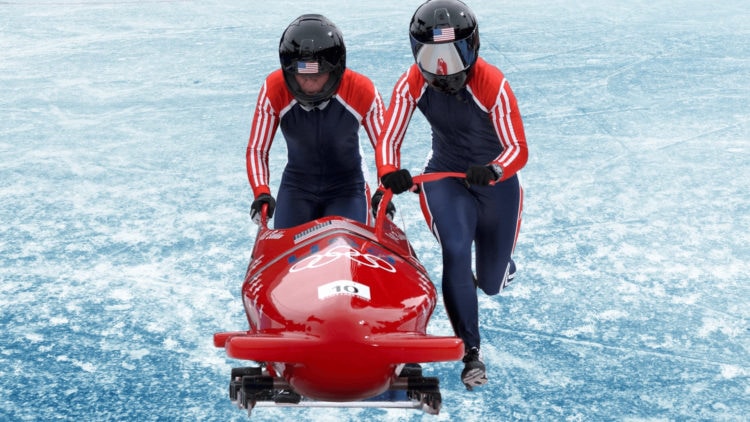
OBJECTIVE OF BOBSLED: Slide down an icy track in a bobsled, reaching the finish line in less time than the other competitors.
NUMBER OF PLAYERS: 1-4 per team
MATERIALS: Bobsled, helmet, protective uniform, goggles, spike shoes
TYPE OF GAME: Sport
AUDIENCE: 16+
OVERVIEW OF BOBSLED
Bobsled is a winter sport that sees competitors ride down an icy track, reaching top speeds of 100+ mph! Controlling any vehicle at speeds faster than most cars will ever reach is no easy feat, but doing so on ice is truly where the challenge of bobsled lies.
SETUP

TYPES OF BOBSLED EVENTS
Bobsled events can differ based on the number of participating athletes:
- Monobob: traditionally an event exclusive to women, monobob involves a single athlete controlling an entire bobsled run.
- Two-Person Bobsled: the most common of the three events, two-person bobsled simply involves sled runs of two individuals per team, with one steering the sled while the other controls the brakes.
- Four-Person Bobsled: as the name suggests, this event involves a large bobsled accommodating four athletes per team. This is the fastest bobsled event, as there is more manpower involved in giving the sled its initial momentum.
TEAM ROLES
There are two ways to control a bobsled: steering and braking. In a monobob event, the athlete must control both of these variables themself. Otherwise, one person is dedicated to each task on a multi-person bobsled run:
- Pilot: the pilot is situated at the front of the bobsled and is responsible for steering the bobsled by manipulating two metal rings to control directional shifts.
- Brakeman: responsible for controlling two brake handles, the brakeman’s job is to slow and stop the bobsled once it crosses the finish line.
- Pusher: every member of a bobsled team is involved in the initial push of the bobsled. In four-person runs, however, the two additional members are there to aid in this task only.
BOBSLED
A bobsled, being the entire focus of the event, must be heavily regulated and maintained to ensure the safety of all involved. A major regulation that must be met is the weight of the sled, which cannot exceed 860 pounds for a two-man sled team or 1,410 pounds for a four-man team (athlete weight included).
A bobsled’s length must not exceed 8.9 feet for a two-man team, nor 12.5 feet for a four-man team. Additionally, the sled’s runners, which are the steel blades located on the bottom of the sled, must have rounded edges and be within a certain temperature range.
TRACK
Bobsled racetracks are often constructed of concrete and coated in a thick layer of ice. Every track is different, although each official course must have one straight section and what is referred to as a “labyrinth”, which is a part of the track that features three back-to-back-to-back turns.
A typical bobsled track is roughly 4,000 feet in length and contains a minimum of 15 turns.
GAMEPLAY

As with most racing sports, the actual gameplay of bobsled is quite self-explanatory: race down a track in a sled and attempt to cross the finish line in the least amount of time possible. While that one sentence sums up the majority of what the sport is, a unique aspect of bobsled lies in what happens at the start of a bobsled run.
The start of a bobsled course involves a straight and non-sloped section of ice that can be up to 160 feet in length. Starting from a dead stop, all competing members of a bobsled team push the sled with as much power and speed as possible before quickly hopping inside the sled right as the track begins to slope downwards. This initial push is where the strength and athleticism of bobsled athletes come into play, and this is the reason why many former NFL players are recruited by Team USA to train for Olympic bobsled events.
With hundredths of a second often separating final run times, the speed generated during the push phase and the skill of a pilot’s minuscule turning adjustments throughout a run are crucial to a team’s success.
HEATS
Each bobsled team is given four runs, or heats, per competition. All four run times are combined together to provide a team’s final time, which is compared to the other teams’ aggregate times.
END OF GAME
The team with the fastest combined time of their four heats is the winner of a bobsled race. In the case that two teams tie, there is no tiebreaker, and both teams are awarded the appropriate medal if tied for a podium spot.
- 30 GAMES TO PLAY OVER TEXT - April 22, 2024
- 20+ FREE PRINTABLE BABY SHOWER GAMES - April 16, 2024
- 20+ College Party Games for the Best Night Ever! - April 2, 2024